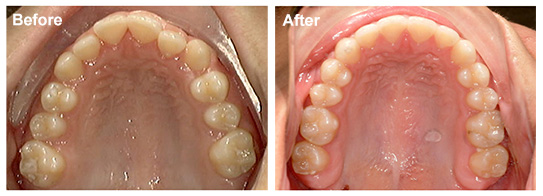November 2nd, 2018

WHEN UPPER AND LOWER DENTAL MIDLINES do not line up and the lower jaw moves to the side on closing, these are signs of a bite functional shift.

When The Upper Arch Is Too Small For The Lower...
When the upper arch is too narrow or too small for the lower jaw, the lower jaw is forced to move to the side when closing. The unwanted movement, called a functional shift, temporarily relieves discomfort by creating a maximum tooth biting surface for chewing. The unnecessary jaw movement can be eliminated by upper arch expansion and comprehensive orthodontic treatment.

The Imbalance Can Be Fixed
The upper jaw may also be too small for the face and the lower jaw. This is called maxillary deficiency. The backward position of the upper jaw can be corrected with Class III rubber bands, reverse pull headgear, or an upper jaw surgical advancement procedure.

This case was treated by board certified orthodontist Dr. Ann Marie Gorczyca of Gorczyca Orthodontics in Antioch, California.
If you have questions about midlines that don’t line up or a jaw functional shift, call us at 925-757-9000. Visit us at www.clubbraces.com.
Straight dental midlines are important. Eliminate your bite functional shift to get your smile into high gear.
Top image used under CC0 Public Domain license. Image cropped and modified from original.
The content on this blog is not intended to be a substitute for professional medical advice, diagnosis, or treatment. Always seek the advice of qualified health providers with questions you may have regarding medical conditions.
Tags: Antioch, orthodontist, dentistry, orthodontics, braces, Dr. Gorczyca, Gorczyca Orthodontics, crossbite, expansion, posterior crossbite, anterior crossbite, Class III, dental midlines, functional shift, jaw shift, jaw surgery, maxillary advancement, maxillary expansion, orthognathic surgery, reverse pull headgear
Posted in Blog | No Comments
July 6th, 2016

WHEN PRESENT, they lead to excessive tooth wear and dark smiles. They cause you to bite your lips and cheeks. They even limit your jaw function. Any way you look at it, crossbites are not good for your dental health.
Crossbites Can Lead To Excessive Tooth Wear
When a front crossbite is present, the upper tooth appears "behind" the lower teeth. If untreated, front tooth crossbite leads to excessive tooth wear.

When a back crossbite is present, the upper tooth is "inside" the lower teeth. Back upper teeth are trapped or tipped towards the tongue. This abnormal tooth position causes your lower jaw to shift. Back crossbites lead to cheek biting, jaw shifting, and the appearance of black space in the corners of your smile.

There Are Different Options To Correct A Crossbite
Braces, Invisalign, or removable expansion appliances can fix crossbites by upper arch expansion.

Visit us at Gorczyca Orthodontics in Antioch, California (925) 757-9000 to find out how dental arch expansion can eliminate your crossbites. To find an orthodontist near you, visit the American Association of Orthodontists at www.mylifemysmile.org.

Sky's the limit with orthodontic possibilities. Eliminate your crossbites today for ideal dental function, comfort, happiness, and life.
Tags: Antioch, orthodontist, orthodontics, braces, Gorczyca Orthodontics, Invisalign, retainers, California, dental, tooth wear, crossbite, teeth, cheek biting, posterior crossbite, anterior crossbite, functional shift, jaw shift, smile, lip biting, crossbites, tooth, front teeth, front crossbite, back teeth, back crossbite, dental function, jaw movements, orthodontic, appliances, dental appliances, removable appliances
Posted in Blog | No Comments
January 9th, 2015

OUCH! WHY DID I DO THAT?... If you occasionally bite your cheek by accident, you may have a posterior crossbite. A posterior crossbite occurs when the upper back teeth are inside the lower back teeth.

When posterior crossbite exists, the inside cheek does not drape out to the side properly. Instead, it can drape inward or get pushed toward the lower teeth during eating. The inside cheek then gets caught between back teeth accidentally when chewing. Ouch!
Crossbite Can Be Painful And Unhealthy

There are two types of posterior crossbites. Posterior crossbites can be all teeth on one side or a single tooth on one side.
Cheek biting is especially painful when second molars are in crossbite and they bite the cheek with a sudden heavy force.
Your Crossbite Can Be Treated By An Orthodontist

Posterior crosssites can be treated as early as age 7.
To find out if you have a posterior crossbite, visit an orthdontist near you. Contact the American Association of Orthodontists at www.mylifemysmile.org.
These crossbites were corrected by orthodontist Dr. Ann Marie Gorczyca of Antioch, Calfornia. Visit us at www.clubbraces.com, or give us a call at (925) 757-9000.
Eliminate cheek biting forever. Enjoy dinner. Bon appetite!




















